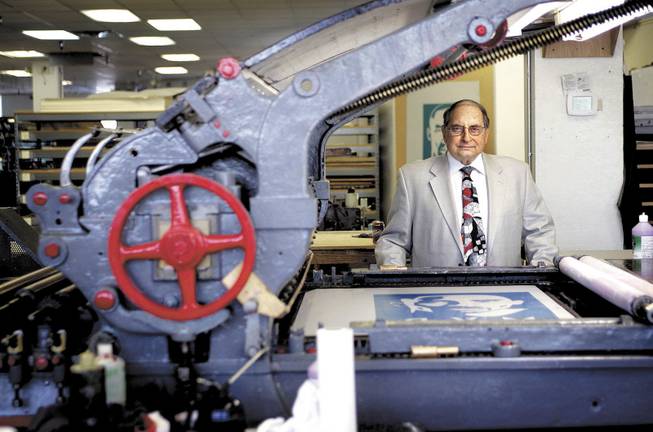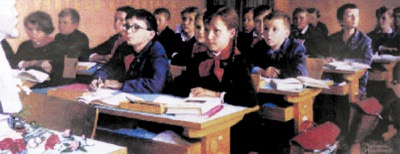
Jack Solomon, owner of S2Art lithography printing studio in Las Vegas, stands by the vintage 1870 Paris-made press he used to print Norman Rockwell lithographs in the 1960s, when he worked with the artist.
Saturday, July 5, 2008 | 2 a.m.
Jack Solomon is in his book-laden office in the Las Vegas Arts District when he gets a call from the FBI.
His Norman Rockwell painting, stolen 34 years ago, has been recovered.
Great, Solomon says, expecting to throw a big party in honor of the painting’s return, clear space on a wall in his Las Vegas home or even sell it for a hefty profit.
But that was more than a year ago. Solomon, owner of the lithography company S2Art, has yet to see the work. In fact, the fight over Rockwell’s “Russian Schoolroom” — painted during the Cold War — has been dragging on for more than a year. Solomon and Rhode Island art dealer Judy Goffman Cutler both claim ownership. They continue to add to the stacks of suits and countersuits, claims and counterclaims, motions, depositions and accusations of inconsistent stories, threats and intentional wrongdoing.
The battle also involves filmmaker Steven Spielberg, who owned the painting when the FBI listed the work as stolen.
The Art Loss Register, a London-based art recovery business that Solomon retained, is in the thick of it. Also involved are the Norman Rockwell Museum in Stockbridge, Mass., a reporter from a Missouri newspaper and one of Solomon’s former employees.
Experts say it could be a year before the case goes to trial and that Cutler and Solomon have already spent more than the painting’s estimated value, which the FBI put at $700,000, the Associated Press has reported.
“I just want my painting back,” Solomon says.
Laurence Cutler, Judy’s architect husband, says that’s not going to happen. “There is really no case here,” he says. “She bought it clear and free. He has no rights to it. It’s that simple. It really is ridiculous, this whole thing.”
But it’s never that simple.
“These are difficult cases to resolve,” says Ronald Spencer, a New York attorney who specializes in art law. “Someone’s got to lose. The question is, ‘Who loses?’ You have the owner and you have the good-faith purchaser.”
Recovery of stolen art is sometimes only the beginning of a long legal process. If the person who has possession of the stolen property refuses to return it (for whatever reason, and there are many), it goes to court.
Go back to 1967. Norman Rockwell, the quintessential American illustrator, had gravitated away from his homey scenes for more controversial subjects such as “The Problem We All Live With,” a compelling portrait about school integration. His 16-by-37-inch oil of Russian students with a bust of Lenin at the front of the classroom is a sign of the times. Lyndon B. Johnson and Leonid Brezhnev edge toward detente. The United States and the then-Soviet Union ban nuclear weapons in space.
In 1968 Solomon, the exclusive dealer of Rockwell lithographs, buys “Russian Schoolroom.” He lends it to a Clayton, Mo., gallery showing Rockwell lithographs five years later. The gallery was part of the larger Chicago-based Circle Galleries, of which Solomon was a principal.
The painting sells for $20,000 at the exhibition, but is stolen from the gallery in a middle-of-the-night smash and grab. It disappears. Solomon files a police report, and the gallery returns the money to the buyer and collects the insurance money.
Headlines of the theft fade from local papers.
In 1988 “Russian Schoolroom” resurfaces at a New Orleans auction, where Cutler buys it for $70,400, puts it in a traveling exhibit, then sells it in 1989 to Spielberg for $200,000.
In 2007, Spielberg’s assistant finds the painting listed on the FBI’s National Stolen Art File. Spielberg contacts the FBI. The FBI contacts Solomon and Solomon waits for the return of his painting.
The painting never arrives.
In May 2007 Solomon begins a lengthy and detailed court case when he files a complaint against Spielberg and FBI Director Robert Mueller to recover possession of the painting, which Spielberg is directed by the FBI to hold onto while the matter is sorted out.
Cutler, trying to remove longtime client Spielberg from the mess, trades Rockwell’s “Peace Corps in Ethiopia” for “Russian Schoolroom.”
In October, a U.S. magistrate judge discharges Spielberg “from any and all liability to all parties with respect to the painting.” In December Spielberg seeks recovery of attorney’s fees of more than $47,000 from Solomon and Cutler.
The court orders the two to split the cost of moving and storing the painting in a climate-controlled Las Vegas warehouse. Neither can visit the work without court permission, and where would they find the time? Both are tied up in the nitty-gritty of filings and research.
In a perfect world, Cutler would reimburse Spielberg, take back the painting and return it to the auction house. “Ordinarily an upstanding auction (house) will take the work back and basically reimburse everybody involved,” says Christopher Marinello, executive director and general counsel of The Art Loss Register, which Cutler is also suing.
But the house from which Cutler bought the painting, Morton M. Goldberg Auction Galleries Inc., went bankrupt, and its owner died.
Franklin Feldman, chairman of the law advisory council of the International Foundation for Art Research, says a painting sold by a thief cannot pass along “good title,” even when it’s bought in good faith. But subsequent purchasers can use defenses to protect their ownership: The original owner waited too long to bring his claim or he didn’t effectively advertise and report the loss. The statute of limitations, in some cases, doesn’t begin until the original owner makes a claim against the new owner.
The Cutlers own the National Museum of American Illustration, located inside their mansion in Newport, R.I. Judy Goffman Cutler says she works seven days a week to prove her case and discount Solomon’s efforts to list the painting as stolen. Solomon and his five attorneys are filing to prove that Cutler did not buy the painting in good faith.
At this point, the usually outspoken Solomon refers questions directly to court documents because the lawyer-turned-businessman already has been slammed with a $25 million libel suit for telling a reporter for an alternative weekly newspaper in St. Louis Cutler “should have known better ... She could have checked that — there’s been a record of this ever since the day it was stolen.” The case was dismissed in August.
IFAR’s Feldman, who says Solomon’s attorney has asked him to be an expert witness, says the major contention will be what Solomon did and what he could have done when the theft occurred.
Solomon filed a burglary report. He says there was no database of stolen art until 1977, when IFAR formed its list, although he didn’t register the painting when the database was formed.
Interpol had its register at the time of the theft, but Solomon says it was his understanding the FBI listed the artwork with Interpol.
After purchasing the work, Cutler toured and advertised the painting, which was written about in a couple of antiques periodicals. It was this publicity that prompted a former employee of Solomon’s to contact Jack and Carolyn Solomon. The ex-employee says they never returned her calls. A newspaper reporter, who also left messages for the Solomons, says his calls were not returned.
Marinello of the Art Loss Register — known for recovering work stolen by the Nazis during World War II — says he’s not willing to discuss pending cases. But he says he is astounded that cases ever come to this.
“I don’t expect people to fight so vociferously against a theft victim,” he says. “I can understand a person fighting to protect their rights, but it gets ridiculous when both sides spend more money on legal fees than the value of the painting.”
Often, he says, “people are shaking down the victim a second time. Art recovery is extremely difficult. It’s very rare where someone will do the right thing. Now everyone gets lawyers involved. It’s all about greed.”
Sun librarian Rebecca Clifford-Cruz contributed to this story.



Join the Discussion:
Check this out for a full explanation of our conversion to the LiveFyre commenting system and instructions on how to sign up for an account.
Full comments policy